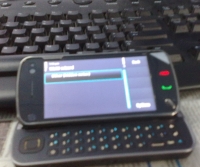How to browse internet on a Linux system using the GPRS/EDGE connection of a phone?
 Using GPRS/EDGE connectivity feature of your mobile phone for surfing on your computers is quite easy if you happen to use Windows, thanks to the dedicted softwares provided by mobile phone manufactures like Nokia's PC-Suite, Motorola's Phone Tools etc. Well, things are not that easy in Tux's world due to the lack of availability of such softwares.
Using GPRS/EDGE connectivity feature of your mobile phone for surfing on your computers is quite easy if you happen to use Windows, thanks to the dedicted softwares provided by mobile phone manufactures like Nokia's PC-Suite, Motorola's Phone Tools etc. Well, things are not that easy in Tux's world due to the lack of availability of such softwares.
Anyways, coming back to using GPRS/EDGE on Linux. Here we will be demonstrating you how to configure settings on your Linux OS, so that you will be able to use GPRS/EDGE for surfing on your computer.
For illustration, we have taken BSNL India (Jharkhand and Bihar circle) as the GPRS/EDGE service provider and the OS is Ubuntu 8.04 LTS. But, things can be easily configured in similar fashion for other service providers as well as other distros like Fedora etc. Although I must mention all the latest distros like Ubuntu 8.10 onwards have added features which lets you configure settings directly from the the 'Network Settings' window. These below mentioned technique is targeted at the older distros but will obviously work for the latest ones too.
Step 1:
Fire up your favourite text editor (we like 'nano') and open 'wvdial.conf ' located in the '/etc/' folder by typing in the following command. Provide your 'root' account password when asked.
sudo nano /etc/wvdial.conf
Step 2:
Delete its content and 'Copy and Paste' the following settings.
[Dialer Defaults]
Init1 = AT+CGDCONT=1,"IP","gprseast.cellone.in"
stupid mode = 1
Modem Type = USB Modem
Baud = 460800
New PPPD = yes
Modem = /dev/ttyACM0
ISDN = 1
Phone = *99#
Password = xxx
Username = xxx
Let me explain these a little bit, so that you can configure it according to the settings provided by your service provider. The settings that your service provider will be providing you will contain an APN address, phone number to be dialed, user name and passwords. Our service providers had these following settings as, APN = ' gprseast.cellone.in '; Phone Number = *99# ; and username and passwords were not required by our service provider, so they were marked ' xxx ' . So, now you can edit the settings as per your service provider's supplied settings. Thats it.
Step 3:
Connect your phone to the computer using USB port. Make sure you select the connection mode as 'Modem'. You should find the option of doing so in : Settings > Connections > USB > Modem. This might vary depending on your phone, for eg, Nokia users will have it as PC-Suite. When you have successfully connected your phone in proper mode to the computer, type in the command : ' lsusb ' at the prompt and your phone should get listed, along with other usb devices that are connected.
Step 4:
Enter the command: ' wvdial ' at the prompt and hit enter. The dialer will dial the number and you will see something like this appearing in your shell window:

As you can see, DNS addresses are automatically supplied by your service provider. If this appears, that means its done. Your computer will automatically start using these settings and you can start surfing. Just make sure that your browser connection settings is set as ' Auto-Detect Proxy settings for this network '. In Firefox this is located at: Edit > Preferences > Network > Settings. And NOTE that you have to keep this shell window open during the entire period of surfing/downloading. You must not close this shell window, otherwise you will get disconnected and will have to dial-in again by carrying out Step 4, i.e re-execute the command 'wvdial'.
Thats pretty much all of it. Go ahead give it a try. It should work for you as it did for us. Do let us know if this worked for you.
And just in case you get stuck with something, feel free to ask us by dropping a comment.